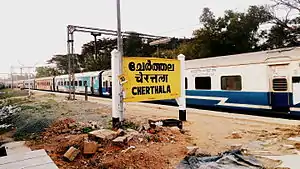Ernakulam–Kayamkulam coastal line
Ernakulam–Kayamkulam coastal line is a railway line which runs along the coastal areas of Alappuzha, Ernakulam districts in Kerala state of India. The coastal railway line starts as a branch line from Ernakulam Junction railway station towards Alappuzha and joins with the route via Kottayam ( Ernakulam-Kottayam-Kayamkulam line) at Kayamkulam Junction. The coastal line has a total distance of 102 km (63 mi). This is the shortest route connecting major cities Thiruvananthapuram and Ernakulam and saves a considerable amount of time when compared to the circuitous route via Kottayam.
| Ernakulam–Kayamkulam Coastal line | |||||||||||||||||||||||||||||||||||||||||||||||||||||||||||||||||||||||||||||||||||||||||||||||||||||||||||||||||||||||||||||||||||||||||||||||||||||||||||||||||||||||||||||||||||||||||||||||||||||||||||||||||||||||||||||||||||||||||||||||||||||||||||||||||||||||||||||||
|---|---|---|---|---|---|---|---|---|---|---|---|---|---|---|---|---|---|---|---|---|---|---|---|---|---|---|---|---|---|---|---|---|---|---|---|---|---|---|---|---|---|---|---|---|---|---|---|---|---|---|---|---|---|---|---|---|---|---|---|---|---|---|---|---|---|---|---|---|---|---|---|---|---|---|---|---|---|---|---|---|---|---|---|---|---|---|---|---|---|---|---|---|---|---|---|---|---|---|---|---|---|---|---|---|---|---|---|---|---|---|---|---|---|---|---|---|---|---|---|---|---|---|---|---|---|---|---|---|---|---|---|---|---|---|---|---|---|---|---|---|---|---|---|---|---|---|---|---|---|---|---|---|---|---|---|---|---|---|---|---|---|---|---|---|---|---|---|---|---|---|---|---|---|---|---|---|---|---|---|---|---|---|---|---|---|---|---|---|---|---|---|---|---|---|---|---|---|---|---|---|---|---|---|---|---|---|---|---|---|---|---|---|---|---|---|---|---|---|---|---|---|---|---|---|---|---|---|---|---|---|---|---|---|---|---|---|---|---|---|---|---|---|---|---|---|---|---|---|---|---|---|---|---|---|---|---|---|---|---|---|---|---|---|---|---|---|---|---|---|---|---|
 Cherthala railway station on Ernakulam–Kayamkulam line | |||||||||||||||||||||||||||||||||||||||||||||||||||||||||||||||||||||||||||||||||||||||||||||||||||||||||||||||||||||||||||||||||||||||||||||||||||||||||||||||||||||||||||||||||||||||||||||||||||||||||||||||||||||||||||||||||||||||||||||||||||||||||||||||||||||||||||||||
| Overview | |||||||||||||||||||||||||||||||||||||||||||||||||||||||||||||||||||||||||||||||||||||||||||||||||||||||||||||||||||||||||||||||||||||||||||||||||||||||||||||||||||||||||||||||||||||||||||||||||||||||||||||||||||||||||||||||||||||||||||||||||||||||||||||||||||||||||||||||
| Native name | എറണാകുളം-കായംകുളം തീരദേശ തീവണ്ടി പാത | ||||||||||||||||||||||||||||||||||||||||||||||||||||||||||||||||||||||||||||||||||||||||||||||||||||||||||||||||||||||||||||||||||||||||||||||||||||||||||||||||||||||||||||||||||||||||||||||||||||||||||||||||||||||||||||||||||||||||||||||||||||||||||||||||||||||||||||||
| Status | Operational | ||||||||||||||||||||||||||||||||||||||||||||||||||||||||||||||||||||||||||||||||||||||||||||||||||||||||||||||||||||||||||||||||||||||||||||||||||||||||||||||||||||||||||||||||||||||||||||||||||||||||||||||||||||||||||||||||||||||||||||||||||||||||||||||||||||||||||||||
| Owner | Indian Railways | ||||||||||||||||||||||||||||||||||||||||||||||||||||||||||||||||||||||||||||||||||||||||||||||||||||||||||||||||||||||||||||||||||||||||||||||||||||||||||||||||||||||||||||||||||||||||||||||||||||||||||||||||||||||||||||||||||||||||||||||||||||||||||||||||||||||||||||||
| Locale | Kerala | ||||||||||||||||||||||||||||||||||||||||||||||||||||||||||||||||||||||||||||||||||||||||||||||||||||||||||||||||||||||||||||||||||||||||||||||||||||||||||||||||||||||||||||||||||||||||||||||||||||||||||||||||||||||||||||||||||||||||||||||||||||||||||||||||||||||||||||||
| Termini | Ernakulam Junction Kayamkulam Junction | ||||||||||||||||||||||||||||||||||||||||||||||||||||||||||||||||||||||||||||||||||||||||||||||||||||||||||||||||||||||||||||||||||||||||||||||||||||||||||||||||||||||||||||||||||||||||||||||||||||||||||||||||||||||||||||||||||||||||||||||||||||||||||||||||||||||||||||||
| Stations | 20 | ||||||||||||||||||||||||||||||||||||||||||||||||||||||||||||||||||||||||||||||||||||||||||||||||||||||||||||||||||||||||||||||||||||||||||||||||||||||||||||||||||||||||||||||||||||||||||||||||||||||||||||||||||||||||||||||||||||||||||||||||||||||||||||||||||||||||||||||
| Website | www | ||||||||||||||||||||||||||||||||||||||||||||||||||||||||||||||||||||||||||||||||||||||||||||||||||||||||||||||||||||||||||||||||||||||||||||||||||||||||||||||||||||||||||||||||||||||||||||||||||||||||||||||||||||||||||||||||||||||||||||||||||||||||||||||||||||||||||||||
| Service | |||||||||||||||||||||||||||||||||||||||||||||||||||||||||||||||||||||||||||||||||||||||||||||||||||||||||||||||||||||||||||||||||||||||||||||||||||||||||||||||||||||||||||||||||||||||||||||||||||||||||||||||||||||||||||||||||||||||||||||||||||||||||||||||||||||||||||||||
| Type | Regional rail Light rail | ||||||||||||||||||||||||||||||||||||||||||||||||||||||||||||||||||||||||||||||||||||||||||||||||||||||||||||||||||||||||||||||||||||||||||||||||||||||||||||||||||||||||||||||||||||||||||||||||||||||||||||||||||||||||||||||||||||||||||||||||||||||||||||||||||||||||||||||
| Services | 1 | ||||||||||||||||||||||||||||||||||||||||||||||||||||||||||||||||||||||||||||||||||||||||||||||||||||||||||||||||||||||||||||||||||||||||||||||||||||||||||||||||||||||||||||||||||||||||||||||||||||||||||||||||||||||||||||||||||||||||||||||||||||||||||||||||||||||||||||||
| Operator(s) | Southern Railway zone | ||||||||||||||||||||||||||||||||||||||||||||||||||||||||||||||||||||||||||||||||||||||||||||||||||||||||||||||||||||||||||||||||||||||||||||||||||||||||||||||||||||||||||||||||||||||||||||||||||||||||||||||||||||||||||||||||||||||||||||||||||||||||||||||||||||||||||||||
| History | |||||||||||||||||||||||||||||||||||||||||||||||||||||||||||||||||||||||||||||||||||||||||||||||||||||||||||||||||||||||||||||||||||||||||||||||||||||||||||||||||||||||||||||||||||||||||||||||||||||||||||||||||||||||||||||||||||||||||||||||||||||||||||||||||||||||||||||||
| Opened | 16 October 1989 | ||||||||||||||||||||||||||||||||||||||||||||||||||||||||||||||||||||||||||||||||||||||||||||||||||||||||||||||||||||||||||||||||||||||||||||||||||||||||||||||||||||||||||||||||||||||||||||||||||||||||||||||||||||||||||||||||||||||||||||||||||||||||||||||||||||||||||||||
| Technical | |||||||||||||||||||||||||||||||||||||||||||||||||||||||||||||||||||||||||||||||||||||||||||||||||||||||||||||||||||||||||||||||||||||||||||||||||||||||||||||||||||||||||||||||||||||||||||||||||||||||||||||||||||||||||||||||||||||||||||||||||||||||||||||||||||||||||||||||
| Line length | 102 km (63 mi) | ||||||||||||||||||||||||||||||||||||||||||||||||||||||||||||||||||||||||||||||||||||||||||||||||||||||||||||||||||||||||||||||||||||||||||||||||||||||||||||||||||||||||||||||||||||||||||||||||||||||||||||||||||||||||||||||||||||||||||||||||||||||||||||||||||||||||||||||
| Number of tracks | 1 | ||||||||||||||||||||||||||||||||||||||||||||||||||||||||||||||||||||||||||||||||||||||||||||||||||||||||||||||||||||||||||||||||||||||||||||||||||||||||||||||||||||||||||||||||||||||||||||||||||||||||||||||||||||||||||||||||||||||||||||||||||||||||||||||||||||||||||||||
| Track gauge | 1,676 mm (5 ft 6 in) | ||||||||||||||||||||||||||||||||||||||||||||||||||||||||||||||||||||||||||||||||||||||||||||||||||||||||||||||||||||||||||||||||||||||||||||||||||||||||||||||||||||||||||||||||||||||||||||||||||||||||||||||||||||||||||||||||||||||||||||||||||||||||||||||||||||||||||||||
| Loading gauge | 4,725 mm × 3,660 mm (15 ft 6.0 in × 12 ft 0.1 in) (BG) | ||||||||||||||||||||||||||||||||||||||||||||||||||||||||||||||||||||||||||||||||||||||||||||||||||||||||||||||||||||||||||||||||||||||||||||||||||||||||||||||||||||||||||||||||||||||||||||||||||||||||||||||||||||||||||||||||||||||||||||||||||||||||||||||||||||||||||||||
| Operating speed | 100 km/h (62 mph) | ||||||||||||||||||||||||||||||||||||||||||||||||||||||||||||||||||||||||||||||||||||||||||||||||||||||||||||||||||||||||||||||||||||||||||||||||||||||||||||||||||||||||||||||||||||||||||||||||||||||||||||||||||||||||||||||||||||||||||||||||||||||||||||||||||||||||||||||
| |||||||||||||||||||||||||||||||||||||||||||||||||||||||||||||||||||||||||||||||||||||||||||||||||||||||||||||||||||||||||||||||||||||||||||||||||||||||||||||||||||||||||||||||||||||||||||||||||||||||||||||||||||||||||||||||||||||||||||||||||||||||||||||||||||||||||||||||
History
The initial survey for the Ernakulam–Kayamkulam line via Alappuzha was started in 1975. The initial proposed alignment of the railway line from Ernakulam Junction to Alappuzha has been changed after protests from various quarters. This line was mentioned in 1977-78 final budget.[1] The final alignment of the route which was approved was Ernakulam–Konthuruty–Nettor–Kumbalam–Aroor–Cherthala–Alappuzha. The construction of railway line was started on 15 April 1979 and the construction has been divided into two reaches as Ernakulam–Alappuzha reach and Alappuzha–Kayamkulam reach.[2]
Ernakulam–Alappuzha section
The construction of this coastal railway line in Ernakulam Junction–Alappuzha railway station section was started in 1979. Construction of Alleppey-Ernakulam new B.G. Railway line has been included in the budget for 1979-80, with a proposed outlay, of Rs. 1 crore in the coming financial year 1979-80.[3] Around 140 hectares of land was acquired for laying the railway lines. 11 new railway stations and 6 major bridges have been constructed along this route. The Aroor Bridge is the Longest Bridge in this section having length of 1,849 m (6,066 ft) The total cost outlay was 7 crores and the total length of the railway line is 58 km (36 mi). The line was opened to railway traffic on 16 October 1989.
Alappuzha–Kayamkulam section
The construction of Alappuzha–Kayamkulam section was started as part of second phase of coastal railway development and the alignment was via Alappuzha–Punnapra–Ambalappuzha–Haripad–Kayamkulam. The total length of the railway line was 44 km (27 mi) and the line was opened to railway traffic on 1992. Thus, the Ernakulam Junction–Alappuzha coastal railway line has been connected to Kayamkulam Junction railway station–Kollam Junction main railway line.
Stations
There are 18 stations along this route. Alappuzha, Cherthala, Haripad, and Ambalappuzha stations are the major stations along this route.
Electrification and track doubling
Ernakulam Junction–Alappuzha–Kayamkulam railway line is fully electrified. The double line work on 14 km (8.7 mi) Kayamkulam–Haripad section has been completed and the double line track was commissioned in January 2012. The track doubling work for Haripad– Ambalapuzha is currently in progress. Track laying between Thakazhi and Ambalappuzha are nearly complete and works between Thakazhi and Haripad are through. Doubling of The 1,849 m (6,066 ft) Long Aroor Bridge has started in 2019.
The doubling works for the Ambalapuzha- Ernakulam junction sector is painfully slow. There is not even a sign of any earth works or anything happening in this stretch at present.
Rail traffic
The Ernakulam–Alappuzha–Kayamkulam coastal line has 20 express trains and 7 passenger trains running along this route. Superfast trains connecting the cities of Thiruvananthapuram and Kochi are increasingly preferring this route to the one via Kottayam because this route is shorter and saves considerable amount of time in reaching these cities. Major trains like Thiruvananthapuram-Kozhikode Jan Shatabdi Express and Thiruvananthapuram-Nizamuddin Rajdhani Express, Trivandrum-Chennai Super AC Express, kochuveli-Chandigarh Kerala Sampark Kranti, Tirunelveli-Gandhidham Humsafar Express, and the Kochuveli-Mangalore Antyodaya Express run via Alappuzha. Mail /Express trains terminating at Alappuzha also use this route.
At present there are no trains towards Palakkad–Pollachi line, Kollam–Sengottai branch line, and Nilambur–Shoranur line passing through this coastal line.
Needed development
- A bypass line connecting Cochin Harbour Terminus railway station line with Alappuzha line near Kochu Kadavanthra and Thevara. It will help decongest Ernakulam Junction railway station and help start more south bound trains via Alappuzha.
- Timely completion of doubling of line and improvement of signalling in a manner such that headway will be minimum. This will help start Kollam - Alappuzha - Kochi suburban trains.
- Building a connection between Aroor Halt and Kanjiramattom on Ernakulam–Kottayam–Kayamkulam line so that a circular suburban rail network can be developed around Kochi. And decongest Ernakulam yard.
References
- "Railway Budget speech 1977-78 (final)" (PDF). www.indianrailways.gov.in. Government of India, Ministry of Railways. 11 June 1977.
- E Sreedharan-Autobiography DC Books, 2014, pages 47-51
- https://eparlib.nic.in/bitstream/123456789/2057/1/lsd_06_07_01-03-1979.pdf Page no. 26